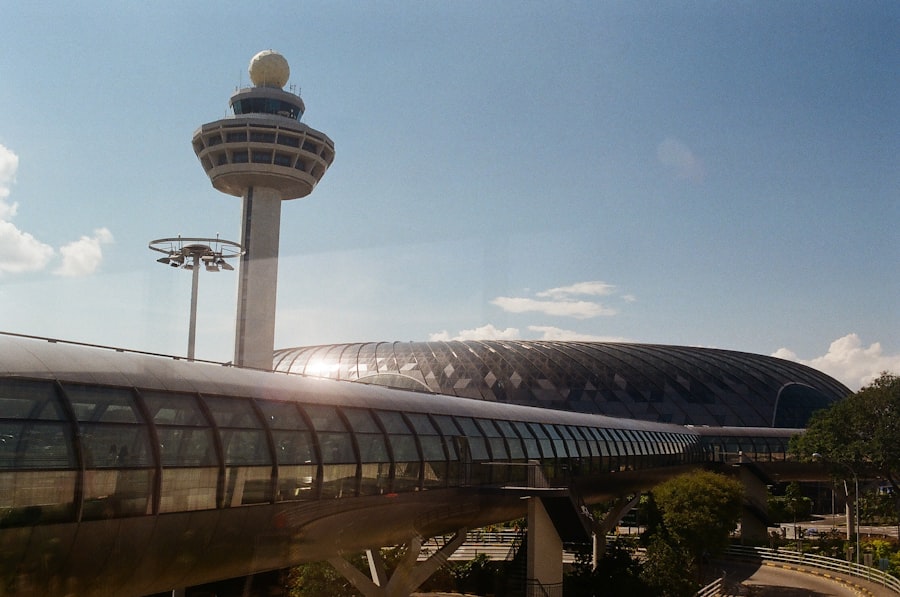
Air traffic control (ATC) is a critical component of the aviation industry, ensuring the safe and efficient movement of aircraft in the skies and on the ground. The role of an air traffic controller is both demanding and rewarding, requiring a unique blend of skills, knowledge, and temperament. Controllers are responsible for managing the flow of air traffic, providing instructions to pilots, and coordinating with other aviation personnel to prevent collisions and ensure timely departures and arrivals.
The profession is often characterized by its high-stakes environment, where split-second decisions can have significant consequences. The allure of a career in air traffic control lies not only in the responsibility of safeguarding lives but also in the dynamic nature of the work. Controllers operate in a fast-paced environment, utilizing advanced technology and communication systems to monitor aircraft movements.
The profession attracts individuals who thrive under pressure and possess strong analytical skills. As air travel continues to grow globally, the demand for skilled air traffic controllers remains robust, making it an appealing career choice for those interested in aviation and public safety.
Key Takeaways
- Air traffic control careers offer a unique and challenging opportunity to work in a fast-paced and critical industry.
- Education and training requirements for air traffic controllers include completing an FAA-approved education program and passing the Air Traffic Standardized Aptitude Test (AT-SAT).
- Air traffic controllers are responsible for ensuring the safe and efficient movement of air traffic, providing clearances, and communicating with pilots.
- The salary and benefits for air traffic controllers are competitive, with opportunities for overtime and shift differentials.
- The job outlook for air traffic controllers is favorable, with opportunities for advancement and career growth within the industry.
Education and Training Requirements for Air Traffic Controllers
Education Requirements
In the United States, the Federal Aviation Administration (FAA) requires prospective controllers to possess at least an associate degree from an accredited institution. However, many candidates opt for a bachelor’s degree in aviation management, air traffic management, or a related field to enhance their qualifications. These programs typically cover essential topics such as aviation regulations, meteorology, navigation, and communication skills, providing a solid foundation for future controllers.
Specialized Training
In addition to formal education, aspiring air traffic controllers must complete specialized training programs. The FAA operates the Air Traffic Collegiate Training Initiative (AT-CTI), which partners with select colleges and universities to offer tailored training for future controllers.
On-the-Job Training
Upon graduation from an AT-CTI program, candidates are eligible to apply for positions within the FAA. Once hired, new controllers undergo rigorous on-the-job training at an FAA facility, where they learn to operate radar systems, communicate with pilots, and manage air traffic under the supervision of experienced controllers. This combination of education and hands-on training equips candidates with the necessary skills to excel in this demanding field.
Job Responsibilities and Duties of Air Traffic Controllers

The primary responsibility of air traffic controllers is to ensure the safe and orderly flow of air traffic within their designated airspace. This involves monitoring aircraft movements using radar and other tracking systems, providing pilots with critical information regarding altitude, speed, and flight paths. Controllers must maintain constant communication with pilots, issuing instructions for takeoff, landing, and in-flight maneuvers.
They also coordinate with other controllers to manage traffic during peak times and ensure that aircraft are safely separated from one another. In addition to managing live air traffic, controllers are tasked with preparing flight plans and conducting pre-flight briefings. They analyze weather conditions and assess potential hazards that could impact flight safety.
Controllers must also be adept at problem-solving; when unexpected situations arise—such as equipment malfunctions or emergency landings—they must quickly devise solutions to mitigate risks. The role requires not only technical proficiency but also strong interpersonal skills, as effective communication is vital for maintaining safety in the skies.
Salary and Benefits of Air Traffic Controllers
| Category | Details |
|---|---|
| Salary Range | 40,000 to 175,000 per year |
| Benefits | Health insurance, retirement plans, paid time off |
| Additional Allowances | Overtime pay, shift differentials |
| Training | Initial training and ongoing professional development |
The compensation for air traffic controllers reflects the high level of responsibility associated with the position. According to data from the Bureau of Labor Statistics (BLS), the median annual wage for air traffic controllers in the United States was approximately $138,000 as of May 2022. Salaries can vary significantly based on factors such as geographic location, level of experience, and the specific facility where a controller is employed.
For instance, controllers working in major metropolitan areas or at busy airports often earn higher salaries due to the increased complexity of their work environments. In addition to competitive salaries, air traffic controllers enjoy a comprehensive benefits package that typically includes health insurance, retirement plans, and paid time off. Many controllers are part of federal employee retirement systems that provide substantial pension benefits upon retirement.
The job also offers opportunities for overtime pay, which can further enhance overall earnings. Given the demanding nature of the work and the extensive training required, these financial incentives make a career in air traffic control particularly attractive.
Job Outlook and Opportunities for Air Traffic Controllers
The job outlook for air traffic controllers remains positive as air travel continues to expand globally. According to the BLS, employment for air traffic controllers is projected to grow by about 4% from 2021 to 2031, which is consistent with the average growth rate for all occupations. This growth is driven by an increase in air travel demand and advancements in technology that enhance operational efficiency within the aviation sector.
Moreover, as many current controllers approach retirement age, there will be numerous opportunities for new entrants into the field. The FAA anticipates hiring thousands of new controllers over the next decade to replace those who retire or leave the profession for other reasons. This influx of job openings presents a favorable environment for aspiring controllers who meet the educational and training requirements.
Additionally, opportunities exist for specialization within the field; controllers can pursue roles in areas such as terminal control, en route control, or even management positions within ATC facilities.
Challenges and Stress of Being an Air Traffic Controller

The Stress of Managing Multiple Aircraft
One of the most significant aspects of the job is the inherent stress associated with managing multiple aircraft simultaneously while ensuring safety at all times. Controllers must maintain intense focus and concentration during their shifts, often working long hours that can include nights, weekends, and holidays.
The Pressure to Make Quick Decisions
The pressure to make quick decisions in high-stakes situations can lead to mental fatigue and burnout if not managed properly. Additionally, air traffic controllers must navigate complex regulations and procedures while adapting to rapidly changing circumstances. For instance, unexpected weather changes or technical malfunctions can disrupt flight schedules and require immediate adjustments to traffic patterns.
Remaining Calm Under Pressure
The ability to remain calm under pressure is crucial; controllers must communicate effectively with pilots while maintaining situational awareness at all times. Support systems such as peer counseling and stress management programs are essential in helping controllers cope with these challenges and maintain their well-being.
Advancement and Career Growth for Air Traffic Controllers
Air traffic control offers various pathways for career advancement once individuals have gained experience in their roles. Many controllers start as entry-level positions at smaller facilities before moving on to larger airports or more complex environments as they accumulate experience and demonstrate their capabilities. With time and proven performance, controllers can advance to supervisory roles or specialized positions that focus on specific aspects of air traffic management.
Moreover, there are opportunities for professional development through additional training programs offered by the FAA or other aviation organizations. Controllers may choose to pursue certifications in areas such as radar operations or emergency response management to enhance their skill sets further. Some may even transition into management roles within ATC facilities or take on responsibilities related to policy development or training new hires.
The potential for upward mobility within this field makes it an appealing long-term career choice for those who are dedicated to continuous learning and improvement.
How to Pursue a Career as an Air Traffic Controller
For those interested in pursuing a career as an air traffic controller, there are several steps to follow that can lead to success in this competitive field. First and foremost, prospective candidates should focus on obtaining the necessary educational qualifications by enrolling in an accredited program that meets FAA requirements. Engaging in coursework related to aviation principles will provide a solid foundation for understanding the complexities of air traffic management.
After completing their education, candidates should seek out internships or entry-level positions within aviation organizations to gain practical experience and insights into the industry. Networking with professionals already working in ATC can also be beneficial; attending aviation conferences or joining relevant associations can help aspiring controllers make valuable connections that may lead to job opportunities. Once candidates feel prepared, they can apply for positions through the FAA’s hiring process or other relevant agencies worldwide.
It is essential to prepare thoroughly for assessments that evaluate cognitive abilities, decision-making skills, and situational awareness—key attributes necessary for success as an air traffic controller. By following these steps diligently and remaining committed to their goals, aspiring individuals can embark on a fulfilling career path within this vital sector of aviation.
This article provides an introduction to the website and the various career resources it offers. You can find more information about air traffic controllers and other career options by visiting this link.
FAQs
What is the role of an air traffic controller?
An air traffic controller is responsible for coordinating the movement of air traffic to ensure that planes stay a safe distance apart and follow designated paths.
What are the educational requirements to become an air traffic controller in the USA?
To become an air traffic controller in the USA, candidates must have a bachelor’s degree from an approved institution or a combination of work experience and education. They must also complete an air traffic management program at the Federal Aviation Administration (FAA) Academy.
What skills are important for a career as an air traffic controller?
Important skills for air traffic controllers include strong communication, decision-making, problem-solving, and multitasking abilities. They must also have the ability to work under pressure and remain calm in stressful situations.
What is the job outlook for air traffic controllers in the USA?
According to the U.S. Bureau of Labor Statistics, the job outlook for air traffic controllers is projected to decline by 10% from 2020 to 2030 due to advancements in technology and automation. However, there will still be opportunities for those retiring or leaving the profession.
What is the average salary for air traffic controllers in the USA?
According to the U.S. Bureau of Labor Statistics, the median annual wage for air traffic controllers in May 2020 was $130,420.



